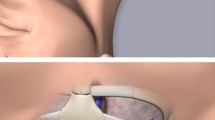Abstract
The aim of this study is to evaluate the effectiveness and safety of percutaneously placed totally implantable venous-access ports (TIVAPs) of the forearm. Between January 2006 and October 2008, peripheral TIVAPs were implanted in 763 consecutive patients by ultrasound and fluoroscopic guidance. All catheters were implanted under local anesthesia and were tunneled subcutaneously. Indication, technical success, and complications were retrospectively analyzed according to Society of Interventional Radiology (SIR) criteria. Presence of antibiotic prophylaxis, periprocedurally administered drugs (e.g., sedation), and laboratory results at the time of implantation were analyzed. Maintenance during the service interval was evaluated. In total, 327,499 catheter-days were analyzed. Technical success rate was 99.3%. Reasons for initial failure of implantation were either unexpected thrombosis of the subclavian vein, expanding tumor mass of the mediastinum, or failure of peripheral venous access due to fragile vessels. Mean follow-up was 430 days. There were 115 complications observed (15.1%, 0.03 per 100 catheter-days), of which 33 (4.3%) were classified as early (within 30 days from implantation) and 82 (10.7%) as late. Catheter-related venous thrombosis was found in 65 (8.5%) of 763 (0.02 per 100 catheter-days) TIVAPs. Infections were observed in 41 (5.4%) of 763 (0.01 per 100 catheter-days) devices. Other complications observed included dislocation of the catheter tip (0.8%), occlusion (0.1%), or rupture (0.1%) of the port catheter. Dislocated catheters were corrected during a second interventional procedure. In conclusion, implantation of percutaneously placed peripheral TIVAPs shows a high technical success rate and low risk of early complications when ultrasound and fluoroscopic guidance are used. Late complications are observed three times as often as early complications.




Similar content being viewed by others
References
Jordan K, Behlendorf T, Surov A et al (2008) Venous access ports: frequency and management of complications in oncology patients. Onkologie 31:404–410
Koolen DA, van Laarhoven HW, Wobbes T et al (2002) Single-centre experience with tunnelled central venous catheters in 150 cancer patients. Neth J Med 60:397–401
Ng F, Mastoroudes H, Paul E et al (2007) A comparison of Hickman line–and Port-a-Cath–associated complications in patients with solid tumours undergoing chemotherapy. Clin Oncol (R Coll Radiol) 19:551–556
Lorch H, Zwaan M, Kagel C et al (2001) Central venous access ports placed by interventional radiologists: experience with 125 consecutive patients. Cardiovasc Intervent Radiol 24:180–184
Bodner LJ, Nosher JL, Patel KM et al (2000) Peripheral venous access ports: outcomes analysis in 109 patients. Cardiovasc Intervent Radiol 23:187–193
Kock HJ, Pietsch M, Krause U et al (1998) Implantable vascular access systems: experience in 1500 patients with totally implanted central venous port systems. World J Surg 22:12–16
Silberzweig JE, Sacks D, Khorsandi AS et al (2003) Reporting standards for central venous access. J Vasc Interv Radiol 14:S443–S452
Sacks D, McClenny TE, Cardella JF et al (2003) Society of Interventional Radiology clinical practice guidelines. J Vasc Interv Radiol 14:S199–S202
Kreis H, Loehberg CR, Lux MP et al (2007) Patients’ attitudes to totally implantable venous access port systems for gynecological or breast malignancies. Eur J Surg Oncol 33:39–43
Marcy PY, Magne N, Castadot P et al (2005) Radiological and surgical placement of port devices: a 4-year institutional analysis of procedure performance, quality of life and cost in breast cancer patients. Breast Cancer Res Treat 92:61–67
Horattas MC, Trupiano J, Hopkins S et al (2001) Changing concepts in long-term central venous access: catheter selection and cost savings. Am J Infect Control 29:32–40
Gebauer B, El-Sheik M, Vogt M et al (2009) Combined ultrasound and fluoroscopy guided port catheter implantation—high success and low complication rate. Eur J Radiol 69:517–522
Seiler CM, Frohlich BE, Dorsam UJ et al (2006) Surgical technique for totally implantable access ports (TIAP) needs improvement: a multivariate analysis of 400 patients. J Surg Oncol 93:24–29
Gebauer B, Teichgraber U, Werk M et al (2007) Periinterventional prophylactic antibiotics in radiological port catheter implantation. Rofo 179:804–810
Da Costa A, Kirkorian G, Cucherat M et al (1998) Antibiotic prophylaxis for permanent pacemaker implantation: a meta-analysis. Circulation 97:1796–1801
Bertaglia E, Zerbo F, Zardo S et al (2006) Antibiotic prophylaxis with a single dose of cefazolin during pacemaker implantation: incidence of long-term infective complications. Pacing Clin Electrophysiol 29:29–33
McGee DC, Gould MK (2003) Preventing complications of central venous catheterization. N Engl J Med 348:1123–1133
Cil BE, Canyigit M, Peynircioglu B et al (2006) Subcutaneous venous port implantation in adult patients: a single center experience. Diagn Interv Radiol 12:93–98
Kurul S, Saip P, Aydin T (2002) Totally implantable venous-access ports: local problems and extravasation injury. Lancet Oncol 3:684–692
Vescia S, Baumgartner AK, Jacobs VR et al (2008) Management of venous port systems in oncology: a review of current evidence. Ann Oncol 19:9–15
Gilsdorf JR, Wilson K, Beals TF (1989) Bacterial colonization of intravenous catheter materials in vitro and in vivo. Surgery 106:37–44
Samaras P, Dold S, Braun J et al (2008) Infectious port complications are more frequent in younger patients with hematologic malignancies than in solid tumor patients. Oncology 74:237–244
McNulty NJ, Kiley DP, Silas AM et al (2009) Implantable subcutaneous venous access devices: is port fixation necessary? A review of 534 cases. Cardiovasc Intervent Radiol. doi:10.1007/s00270-009-9758-5
Author information
Authors and Affiliations
Corresponding author
Rights and permissions
About this article
Cite this article
Goltz, J.P., Scholl, A., Ritter, C.O. et al. Peripherally Placed Totally Implantable Venous-access Port Systems of the Forearm: Clinical Experience in 763 Consecutive Patients. Cardiovasc Intervent Radiol 33, 1159–1167 (2010). https://doi.org/10.1007/s00270-010-9854-6
Received:
Accepted:
Published:
Issue Date:
DOI: https://doi.org/10.1007/s00270-010-9854-6




